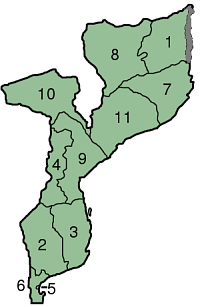Mwani language
| Mwani | |
|---|---|
| Native to | Mozambique[1] |
Native speakers |
100,000 (2006)[2] 2nd language: 20,000[3] |
| Latin | |
| Language codes | |
| ISO 639-3 |
wmw |
| Glottolog |
mwan1247[4] |
G.403[5] | |
|
The area where Kimwani is spoken is in gray. | |
The Mwani language, or Kimwani (pronounced [kiˈmwani]), is spoken on the coast of the Cabo Delgado Province of Mozambique, including the Quirimbas Islands. Although it shares high lexical similarity (60%) with Swahili, it is not intelligible with it. It is spoken by around 120,000 people (including 20,000 who use it as their second language). Speakers of Kimwani also use Portuguese, (the official language of Mozambique), Swahili and Makhuwa language. Kiwibo, the dialect of the Island of Ibo is the prestige dialect. Kimwani (sometimes spelled as Quimuane) is also called Mwani (sometimes spelled as: Mwane, Muane) and Ibo. According to Anthony P. Grant:[6] 'Kimwani of northern Mozambique appears to be the result of imperfect shift towards Swahili several centuries ago by speakers of Makonde', and Arends et al. suggest it might turn out to be a Makonde–Swahili mixed language.[7]
Name
The Name "Kimwani" comes from the word "Mwani", meaning "beach". The prefix "Ki" means the language of, so "Kimwani" literally means "language of the beach".
Sounds
Kimwani (similar to Swahili) is unusual among sub-Saharan languages in having lost the feature of lexical tone (with the exception of some verbal paradigms where its use is optional). It does not have the penultimate stress typical of Swahili; it has movable pitch accent. Labialization of consonants (indicated by a [w] following the consonant) and palatalization of r (ry; [rj]) are frequent. Nasalization of vowels occurs only before a nasal consonant n followed by a consonant.
Vowels
Kimwani has five vowel phonemes: /a/, /e/, /i/, /o/, and /u/, that is: its vowels are close to those of Spanish and Latin. It does not have a distinction of closed and open mid vowels typical of Portuguese, French or Italian.
The pronunciation of the phoneme /i/ stands between International Phonetic Alphabet [i] and [e]. Vowels are never reduced, regardless of stress. The vowels are pronounced as follows:
- /a/ is pronounced like the "a" in start
- /e/ is pronounced like the "e" in bed
- /i/ is pronounced like the "y" in happy
- /o/ is pronounced like the "o" in or
- /u/ is pronounced like the "u" in Susan.
Kimwani has no diphthongs; in vowel combinations, each vowel is pronounced separately.
Consonants
Two symbols in a table cell denote the voiceless and voiced consonant, respectively.
| Labial | Alveolar | Palatal | Velar | Glottal | |
|---|---|---|---|---|---|
| Nasal | m | n | ɲ | ŋ | |
| Plosives and affricates |
p, b | t, d | tʃ, dʒ | k, g | |
| Fricatives | f, v | s, z | ʃ | h | |
| Trill | r | ||||
| Approximants | w | l | j |
Orthography
Kimwani can be spelled in three ways: using orthography similar to Swahili, using a slightly modified spelling system used in Mozambique schools or using a Portuguese-based spelling. Here are the differences:
| Swahili language spelling | Modified spelling | Portuguese spelling | Translation | |
|---|---|---|---|---|
| /tʃ/ | chala | cala | tchala | finger |
| /dʒ/ | juwa | juwa | djua | Sun |
| /k/ | kitabu | kitabu | quitabo | book |
| /ŋ/ | ng' ombe | ng' ombe | ngombe | cow |
| /ɲ/ | nyoka | nyoka | nhoca | snake |
| /s/ | fisi | fisi | fissi | hyena |
| /z/ | meza | meza | mesa | table |
| /ʃ/ | kushanga | kushanga | cuxanga | to admire |
| /w/ | wakati | wakati | uacate | time |
| /j/ | kipya | kipya | quípia | new |
| /i/ | sukili | sukili | suquile | sugar |
| /u/ | ufu | ufu | ufo | flour |
Numbers
m’moja (1), mbiri (2), natu (3), n’né (4), n’tano (5)
sita (6), saba (7), nane (8), khénda (9)
kumi (10), kumi na m’moja (11), kumi na mbiri (12)
shirini (20), talatini (30), arubaini (40), amusini (50)
sitini (60), sabini (70), tamanini (80), tusuini (90)
mia (100), mia mbiri (200)
álufu (1000)
External links
- ↑ Ethnologue list of countries where Kimwani is spoken
- ↑ Mwani at Ethnologue (18th ed., 2015)
- ↑ "Mwani: a language of Mozambique". Ethnologue: Languages of the World (14th ed.). SIL International. Retrieved November 1, 2011.
- ↑ Hammarström, Harald; Forkel, Robert; Haspelmath, Martin; Bank, Sebastian, eds. (2016). "Mwani". Glottolog 2.7. Jena: Max Planck Institute for the Science of Human History.
- ↑ Jouni Filip Maho, 2009. New Updated Guthrie List Online
- ↑ Smith, Norval; Veenstra, Tonjes (2001). Creolization and Contact. John Benjamins Publishing. p. 94. ISBN 90-272-5245-9.
- ↑ Arends, Muysken, & Smith (1995), Pidgins and Creoles: An Introduction
- ↑ A sketch of Kimwani by Petzell, Malin
References
- Petzell, Malin. A sketch of Kimwani (a minority language of Mozambique); Africa & Asia, #2, pp. 88–110, Göteborg University. 2002. ISSN 1650-2019
- Namuna ya kufifunda kufyoma na kwandika (Manual de transição, língua Kimwani); SIL & JUWA; Pemba, Cabo Delgado, Mozambique. 2002.
- Gerdes, Paulus (2008). A Numeração Em Moçambique. Lulu.com. ISBN 978-1-4357-2634-5.
